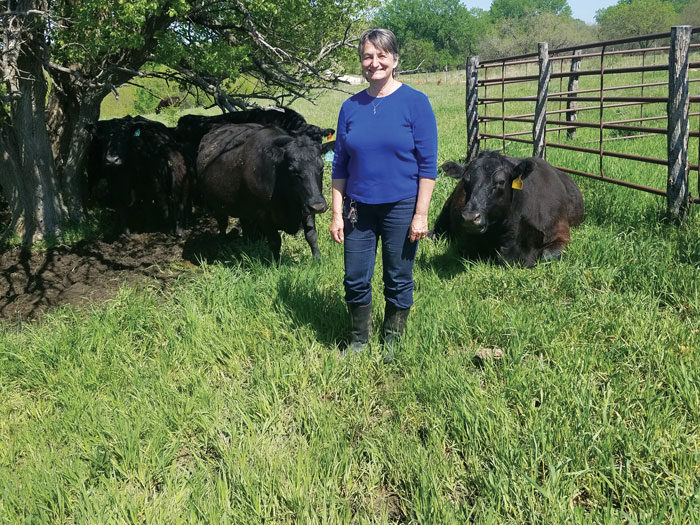We have a diversified 1,000-acre farm in north central Kansas, growing wheat, rye, oats, triticale, milo, soybeans, brome, alfalfa and native prairie hay. We have a 125-head cow-calf operation that we custom calve and custom graze for seven different growers and we finish 6-10 head of grass-fed beef on prairie grass and with cover crops.
We’ve been no-tilling for 20 years, and we started using cover crops 17 years ago. My husband drilled spring oats into the wheat stubble one summer in the back half of the field, so no one could see it from the road. It did so well. It was chest high on me when it was done. We were low on hay that year, so we put a hot wire around it and put the cattle in there. They did so well that we grazed them until the end of February on that grass.
When the cattle came off the oat grass, they looked like they were ready to earn a prize at the county fair. So, we decided to keep using it, and we eventually started adding other things into it, such as radishes and winter peas. Oats grow quickly, they’re very versatile and the cattle love them. You can graze them, but you can also hay it. They love that hay in the wintertime, which was a surprise to us. It looks like straw, but it has a lot of nutrition in it. Mixing it with winter peas gives it some nutrition as well. So, the cattle really like those bales.
Bonus Soil Benefits
We didn’t start out trying to improve the soil. We just needed some grazing. So, it’s interesting that soil health came along with it. We had severe droughts 3 out of the last 10 years, and the cover crop wasn’t as tall as normal. Amazingly, it was packed with more nutrition even though it wasn’t as tall.
“We naturally have a tan clay soil, but now, our soil is dark brown…”
We naturally have a tan clay soil, but now, our soil is dark brown. We have much better soil aggregation — it looks like brown cottage cheese instead of a chalky tan. We’ve been able to double and triple our organic matter. That sounds great, but we started out pretty low, so it’s easy to double or triple it. Now it takes less than 10 minutes to infiltrate an inch of water. So, in 1 hour, I can infiltrate 6 inches of water. That really helps, because we can keep the limited rainfall that we do get in our soil, and it doesn’t cause erosion or run downstream.
Grazing Progression
We seed our covers immediately after harvest. We never take the tractor off our drill. We do a sequence of cover crops in the same field, one right after the other, primarily for grazing, but also to improve the soil. The premise is to take half and leave half, because we want the livestock to trample, defecate and urinate on what they don’t eat, because this creates compost that improves the soil health. Nothing is wasted.
We seed a spring oat-pea cover crop for grazing on March 1 and start grazing it on April 15. We let that rest and regrow while grazing another cover crop field, so that we can re-graze it up to 3 times, depending on how much rain we get. That third grazing might be hayed instead.
After May 15, we graze native grass. We also plant a summer cover crop for grazing. This includes legumes like cowpeas, mung beans, sunn hemp, sorghum-sudangrass, dwarf brown midrib forage sorghum, pearl millet and Japanese millet. We also add some forbs like spineless okra, sunflower and buckwheat. This is planted between May 15 and June 15 and grazed between July 15 and September 15.
We also seed a fall cover crop that we sometimes stockpile for late winter grazing. It’s triticale and oats, with twice as much triticale as oats. If it’s late, we may skip the oats and just put 90 pounds of triticale in. We include legumes like hairy vetch, forage pea, crimson clover, and sometimes add an annual ryegrass, brassicas, radishes, turnips and collards. We’ve found that we don’t want to use more than 2 pounds of brassicas, otherwise the cattle have intense diarrhea. We plant this between July 1 and September 1 and graze it between October 15 and March 1. If they need more protein, we either give them a protein tub or roll out some alfalfa bales. This mix heals the soil, reducing fertilizer needs each time — we have even grown it without any fertilizer.
We also interseed covers into our row crops, such as 1 pound per acre each of buckwheat, mustard and radish interseeded with soybeans. We also seed companion crops with milo, including buckwheat, flax, mustard, annual lespedeza, mung beans, radishes and either mini pumpkins or squash. With wheat, we seed common vetch, lentils and radishes. In the middle of winter, when it’s going to snow, we frost-seed about 10 pounds of red clover and let the melting snow take the seed into the soil.





